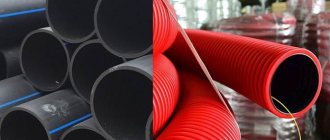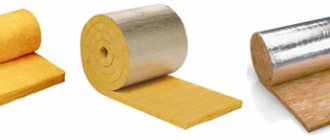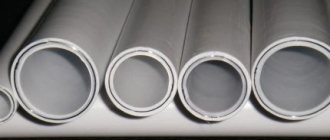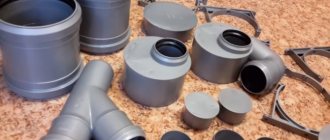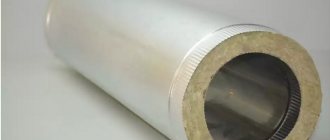When organizing an individual water supply for a house with water taken from a well or borehole, it is necessary to take measures for the normal operation of the water supply system in winter to prevent freezing of the water in the pipe. Therefore, the question of how to insulate a water pipe in the ground with your own hands is relevant for all users of their own water supply line. To insulate a pressure water pipeline underground, it is necessary to calculate and select the most optimal insulation option and install it correctly in compliance with the technology.
Rice. 1 Map of soil freezing levels
Why do you need to insulate pipes?
If you look at the map of freezing depths, you can see that in the northern regions it reaches 2.4 meters - naturally, digging holes of such depth on your site is too expensive. In addition, this is irrational from the point of view of supplying water from a well or well to the house; problems will arise with the well - the pressure pipe must come out of the head and in order to install pumping equipment it will be necessary to dig out and equip a caisson or a caisson pit of very great depth. Using insulation for water pipes in the ground, you can lay a water main at a shallow depth, saving money and increasing the ease of use and maintenance of pumping equipment.
Another advantage of insulating water pipes in the ground is saving resources. The water entering the house is heated for domestic needs and heating - it is clear that heating colder water will require more electricity. If the pipes are insulated from cold soil, then the costs of insulation and work will not only be fully recouped over time, but will also bring significant savings.
An effective way to combat freezing of water pipelines is to use an electric cable, which is glued to the line along its entire length and lowered into the well. Placing the cable and pipeline as additional insulation in a warm shell will significantly save energy when heating the water main.
Rice. 2 Table of heat losses depending on the thickness of the insulator
Useful tips
It is recommended to adhere to a number of rules to avoid a difficult situation:
- when laying pipes in the soil, you need to draw up an exact diagram of their location, paying special attention to the connecting nodes;
- it is necessary to thermally insulate the pipeline along its entire length: inside and outside the facility.
As a temporary measure, it is permissible to use a larger diameter pipe into which the pipeline will be inserted. Inside it is filled with foam. This option is used when it is necessary to protect a small section of communications of a complex configuration for a certain period.
Source: https://vodasovet.ru/vodoprovod/teploizolyatsiya-trub
The main methods of insulating an underground water main
There are several methods of insulating water pipes, which have different principles of operation, some of them are used only in the industrial sector.
Use of insulation materials
The use of building materials with a low thermal conductivity coefficient is one of the simplest methods, which is the most common when insulating pipes in the ground and on the surface. Materials may be placed around the pipes or applied to their surface in the form of paint, resin or foam. The technology is widely used in the industrial sector, for insulating water supply and sewerage systems in private homes.
Heating cable
An electric heating cable is placed inside or close to the pipe and heats it, preventing the water from freezing. The cables themselves are sold in specialized stores, their power ranges from 10 to 20 watts per linear meter; the use of a cable system allows you to bury a water supply system at a distance of no more than 50 cm from the surface of the earth.
The advantages of using a cable are the ability to be placed directly in the water, this allows it to be mounted inside a pipeline and lowered into a well to a considerable depth. The use of an electric cable inside the pipes simultaneously with the installation of external insulation is the most effective and economical solution for protecting the water main from freezing during individual water supply.
Rice. 3 Thermal conductivity of various materials
Air insulation
A more expensive method that is used in industrial and public utilities. When it is used underground, the pipeline is insulated from above using insulation, and warm air is supplied from below, warming the water supply.
A method often used is when the pipeline is placed in a large diameter pipe, inside which warm air passes. This method is usually used to insulate a water main running along the surface; it can also be used in individual areas if the pipeline is buried in the ground - the air gap will prevent the water from freezing without heating.
Pressure insulation
Using pressure, water supply systems are protected from freezing in underground main systems or in unheated rooms; a special receiver is used to increase the pressure. The pressure in the system with this method exceeds 5 atmospheres, while standard pumping equipment for organizing individual water supply is designed to operate with a pressure of no more than 3 bar.
Rice. 4 Electric heating cable - appearance
This technique was developed for use in industrial and municipal engineering communication systems; in everyday life, the use of high pressure is effective if there is a high-quality pipeline and devices designed to work with high pressure. To implement the method, it is necessary to pump water into the main line using an electric pump under a pressure of more than 5 bar. and turn off the pumping equipment - theoretically, water at this pressure should not freeze for a very long time in the absence of the owners.
Basic requirements for materials
The material that can be used when carrying out thermal insulation work must meet the following requirements:
- Have low thermal conductivity. This is the main requirement; choosing a product with a low coefficient will effectively protect the pipeline from freezing and save money.
- It is good to tolerate the effects of chemical and organic substances contained in the soil, and have biological resistance to various types of microorganisms and bacteria.
- Have a long service life without losing its physical characteristics.
- The insulation should not be afraid of exposure to moisture, absorb and allow water to pass through, its physical parameters should not change in the aquatic environment.
- Exposure to high and low temperatures, as well as their changes, should not destroy the insulator and affect its physical properties.
Insulating materials for pipes
Modern industry has mastered the production of ready-made water pipes in an insulating shell, which is covered with a layer of waterproofing on top. When using piped water supply at home, in most cases you will have to do the insulation yourself, deciding how best to insulate the water pipe underground by choosing one of the methods below.
Sprayed insulation (PPU)
A method rarely used in everyday life consists of thermal insulation of a pipeline by spraying polyurethane onto its surface. The advantages of the method are that it provides 100% tightness and allows you to adjust the thickness of the fill; the disadvantages include the very high cost of the material and the work performed.
In addition to polyurethane, the insulating shell is made of liquid foam, the cost of which is lower than polyurethane spraying.
Rice. 5 Thermal insulation by spraying polyurethane and foam
Thermal insulation paint
One of the high-tech products, it is a thick acrylic-based mass containing the smallest particles of perlite, fiberglass, foam glass and glass-ceramic microgranules with a vacuum and a thermal conductivity of 0.00083 W/(m*K), providing basic thermal insulation.
Rice. 6 Thermal insulation of water supply pipes with paint
Typically, paint is applied to the surface in a layer of up to 4 mm, replacing insulation with a thickness of several tens of millimeters. Thermal insulation paint is supplied in special containers, has the form of a white or gray paste, which can be tinted; to thermally insulate sections or the entire pipeline, it is applied with a brush or by spraying. The advantages of using thermal insulation paint are:
- High degree of adhesiveness, allowing paint to be applied to steel and plastic surfaces with good adhesion.
- Possibility of effective operation in a wide temperature range from -70 to +260 C.
- Insulating a water pipe in the ground with paint reliably protects it from corrosion - this is a big advantage when using steel water pipes on a site.
- The material has a long service life, reaching up to 15 years; the possibility of painting it in various colors allows you to use paint on open pipes indoors, choosing a color that does not disturb the interior.
- According to the manufacturer, heat-insulating paint has the lowest thermal conductivity coefficient of all insulation materials, equal to 0.0012 W/(m*K), while air has a thermal conductivity of 0.023 - 0.026 W/(m*K). Some experts accuse the manufacturer of deceiving the consumer and indicate other figures in their calculations - 0.0698 W/(m*K).
The main disadvantages of paints include their high cost; covering one square meter with three layers (this achieves the best efficiency) will cost the homeowner at least $15.
The most well-known brands of insulating paint - Corundum, Isollat, Thermosilat - are produced in plastic buckets of 20 liters and weigh 9.5 kg, can be diluted with water and are usually applied with special types of airless sprayers.
Glass wool
Although glass wool is currently not used on the same scale as before, special cylindrical shells of different diameters with one cut, often covered with foil insulation, are produced for pipe insulation. Cotton wool has a long service life, good thermal conductivity parameters, is not afraid of moisture, and is not affected by high and low temperatures.
The disadvantages include its low density - when buried in the ground, it is necessary to take measures to strengthen the outer shell, otherwise the insulation layer compressed by the earth will have a higher thermal conductivity.
Rice. 7 Thermal insulator made of glass wool
Mineral wool
There are two types of mineral water: slag and basalt; slag mineral wool has the same low density as glass wool and is well saturated with water - because of these qualities, it is practically not used as an insulating material. Basalt insulation is much denser than slag wool, therefore it is more widely used. It is produced in the form of cylindrical shells of different sizes with a slot for installation, covered with foil insulation or glassine.
Such insulation has sufficient density to be immersed in the ground and is resistant to temperature effects, but it absorbs water, thereby losing its thermal insulation properties. Also, the disadvantages include the rather high cost of basalt wool.
Rice. 8 Basalt wool shell
Foamed polyethylene
Polyethylene foam insulation is the most commonly used type for protecting internal and external pipelines. Polyethylene is not afraid of water, temperature changes over a wide range, is biologically and chemically stable, and has a very low density. Insulation is produced without a protective hard shell (some types have a thin foil coating, which can be ignored), so its use underground without additional surface protection in the form of durable pipes or ducts is ineffective.
Polyurethane foam (PPU)
This material is no less effective insulation. To insulate the pipes, a polyurethane foam shell is used, which is a cylinder. It is made in two ways:
- By pouring liquid polyurethane under high pressure into a special mold:
- Manufactured using the “pipe in pipe” method. In this case, the material is poured into the cavity between two pipes - the inner one, with a smaller diameter, and the outer one, with a larger diameter.
The first option is suitable for insulating an independent pipeline. And the product of the second production method is pre-insulated pipes that are ready for laying a new pipeline.
- This is a completely new product that makes it possible not to think about additional insulation;
- In this case, the outer layer can be corrugated - flexible, which makes it possible to avoid the need to use rotary fittings, that is, the pipeline can be laid with a minimum number of connections;
- Both one- and two-pipe versions of such ready-made elements are produced;
- For laying a cold pipeline, structures with plastic pipes are better suited;
- For hot dishes, they produce more expensive options with metal pipes inside;
- Flexible pipes with pre-insulation are supplied in coils and have a length of up to 200 meters.
Regarding the PU shell, it has the following advantages:
- Heat loss is reduced by almost 40%;
- The installation of the elements is so simple that it allows you to independently insulate several hundred meters of pipeline in a day;
- This also indicates the speed of installation;
- The material is environmentally friendly;
- The insulation can be reused an unlimited number of times;
- The service life reaches 30 years.
Among the disadvantages is the inability to use the material at temperatures above 120°C. A great convenience is the presence of shaped segments, such as tees, elbows and branches. The two shell fragments are connected to each other using a special coupling, which makes the thermal insulation airtight and prevents the formation of cold bridges.
differs in coating material,
- Uncoated polyurethane foam is the most affordable, but can only be used for insulating pipes located, for example, in the basement, and then only if there is an additional casing. Either as an intermediate insulating layer;
- Shell with foil coating - the scope of application is not limited, and the material is characterized by increased strength;
- Shells coated with fiberglass can be used to insulate external sections of the pipeline, for example, places where pipes enter the house. It is distinguished by its resistance to ultraviolet radiation. At the same time, fiberglass is also distinguished by high hardness levels, which practically eliminates the possibility of mechanical damage;
- The glassine coating is resistant to direct sunlight, but is inferior to fiberglass in strength;
- Shell coated with reinforced aluminum foil (armofol) - used for insulation of pipelines operated under conditions of significant temperature changes;
- Galvanized steel coating is used to insulate pipelines running in air. Steel protects the shell from ultraviolet radiation, mechanical and biological influences, but at the same time is more affordable than a fiberglass coating.
The thickness of the shell is 20-80 mm and increases with increasing diameter. The length of one element does not exceed 1000 meters, taking into account the peculiarities of the manufacturing process.
What should be the thickness of the insulation layer of the underground section of the pipe?
The formulas for calculating the thickness of insulation are quite complex; only qualified specialists in this field can understand them. For the average consumer, there is no need to independently calculate the thickness; you can always get advice from the seller or use an online calculator for calculations. Typically, such calculators include data from branded insulation materials, among which you can find the type that best matches the parameters being installed and use it for calculations. The calculator also includes parameters of the pipeline, air temperature and physical characteristics of the flowing water.
Rice. 10 Online calculator for calculating insulation thickness
How to insulate a water pipe in the ground with your own hands
When choosing how to insulate a water pipe on a site, they take into account the material of its manufacture, the outer diameter, the cost of the insulation and the complexity of the installation work.
Rice. 11 Calculation of the thickness of the pipe heat insulator
Installation of insulation
Typically, low-pressure polyethylene pipes (HDPE) with a diameter of 1 inch are used to supply water for individual water supply; installation of the insulation shell is carried out in the following way:
- Install a shell made of glass wool, mineral wool or polystyrene foam, polyethylene foam, fixing it with adhesive tape. When installing mineral or glass wool, it is necessary to ensure the tightness of the joints - otherwise water will get into the joint and the wool will saturate it, and the thermal insulation properties of the insulation will be significantly reduced.
- After installation, the soft heat insulator can be protected from compression by the soil with a more durable material; usually they use roofing felt, wrapping it around the shell several times and securing it with tape. The advantage of its use is hydrophobicity, which protects the insulation from moisture absorption.
- The insulated pipeline is lowered into the channel and covered with a light granular composition to reduce pressure; expanded clay is usually used.
It is clear that installation of foam insulation, in contrast to low-density types, is much simpler, and it does not place high demands on the tightness of joints.
It should be taken into account that the installation of plastic segments must be carried out by fastening them to each other with a slight shift of 20 cm, like an overlap connection.
Fig. 12 Insulation of a plastic water pipe in the ground with a foam shell
Cabling
Installation of an electrical cable will cost more, but the depth of the pipeline is minimal. The heating cable can be located inside or outside the pipeline; water pipes are commercially available with an installed electric cable or with a cable channel for its installation. Most often, cable installation is used on the surface, while the depth of the pipeline does not exceed 50 cm. Installation of a cable heater consists of the following stages:
- The pipeline at the location of the cable (in a spiral or straight line) is covered with foil adhesive tape.
- The electrical cable is laid on the glued tape and secured with the same adhesive tape.
- A shell of basalt insulation is installed on top of the resulting structure, which is connected with tape. When installing a heating cable along a line, it is practical to use foam insulation with special grooves.
- To monitor the operation of the system, it is advisable to install temperature sensors along the water supply line.
Rice.
13 How to insulate a water pipe underground with an electric cable When deciding how best to insulate a water pipe in the ground with your own hands, many people prefer a foam shell - it is easy to install, has better physical parameters and is low in cost. It is more practical to use an electric cable when the water pipes and well head are shallow - it can be used to simultaneously heat the water in the main and the well.
Mineral wool
In private construction, mineral wool is most often used to insulate underground pipelines.
It’s easy to work with – just cover the pipes with this material and secure it with tape.
The degree of protection of pipes with mineral wool is quite high, and it is inexpensive.
Mineral wool is not susceptible to rotting, which is undoubtedly a big plus for insulation used in the ground.
One of the types of mineral insulation intended for insulating pipelines laid in the ground is basalt shell. Structurally, it is similar to polyurethane foam shells. The surface of the semi-cylinders has a protective coating - made of aluminum foil, fiberglass, fiberglass, etc.
During installation, the basalt shells are covered with metallized foil. Transverse joints between individual insulation elements are similarly protected.

